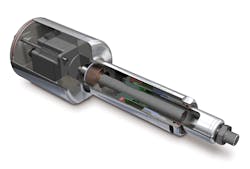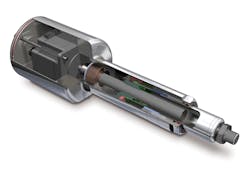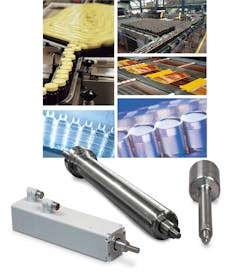Review of features on actuators that resist washdown
Today, automated plants subject to the most-stringent USDA regulations process dairy, meat, and eggs. But even plants not under USDA jurisdiction (such as bakeries and bottling centers) still follow general USDA guidelines. The machines in such facilities have actuators that often get coated in food spills, drips, and spatters that attract dust, bacteria, and fungi. So, the actuators need regular cleaning.
A common way to cut down on the cleaning of actuators not specifically designed for washdown is to add shielding, plates on the actuator that deflect macro-debris. But shields complicate equipment designs and can interfere with washdown and maintenance tasks. Plus, in a lot of cases, it’s now possible to get washdown-ready actuators — fully sealed, self-contained motion devices — as stock items that cost less than shielded actuators.
Washdown actuators usually have an IP65 or IP67 rating that indicates they resist ingress of dust and high-pressure washdown under static conditions (so dust and water don’t get inside and damage the actuator motor or internal mechanisms). An IP69K rating indicates an actuator can withstand extreme washdowns, though even IP69K doesn’t imply an actuator can resist chemical attack from aggressive cleaning solutions. So, know what cleaning solutions are used and what seals are on the actuator to ensure compatibility.
The most rugged housings for washdown actuators are constructed of AISI 300 Series stainless steel (excluding types 301 and 302). 304 and 316 steels are most widely used. Aluminum-alloy actuator bodies are acceptable in some dry-product processing applications not subjected to caustic cleaning or the corrosive action of dissimilar metals. Metal alloys other than stainless steel or aluminum are sometimes suitable, but alloys containing lead, leachable copper, or other toxic metals must be avoided. Surface coatings on actuators must be FDA approved.
All washdown actuators (pneumatic, hydraulic, and electric) have seals to keep out dust, drips, and washdown detergents. Seals and gaskets (as well as other plastic or rubber parts and accessories) must be nontoxic and withstand cleaning without disintegrating. The FDA maintains a list of approved materials, but the most common are Viton for O-rings and seals and ultrahigh-molecular-weight (UHMW) polyethylene for mechanical parts. On actuators with O-rings, it’s critical that the O-ring completely fills the gap between the mating parts. Likewise, where two parts meet with a gasket, the adjacent surfaces and gasket must be flush. Protruding or recessed gaskets can form crevices that collect moisture, food debris, and bacteria.
Housings shouldn’t have crevices, either. They should have rounded surfaces and edges with smooth finishes to shed moisture. Generally, a Number 4 ground finish on stainless steel (free of pits, cracks, and folds) is suitable. For welded junctions, electropolishing, glass beading, and shot peening aren’t acceptable alternatives to a Number 4 finish. Permanent joints in the actuator construction, as where the motor housing joins the screw barrel, are either welded or gasketed, though all the junctions should be fully cleanable when assembled. It’s best to avoid actuators with grooves along the screw body to accept position switches.
Fasteners on actuators for washdown environments should shed water freely. This necessity disqualifies socket-head bolts, counterbored holes, slotted screws, and knurled fasteners, because they all have crevices that collect debris. Hex-head bolts and dome nuts are more appropriate. In addition, fastener threads should never be exposed.
Actuator lubricants subject to incidental food contact should be FDA-approve food-grade oils and greases. Proper seals between the actuator body and the rod on an IP67 or IP69k-rated product typically minimize lubricant exposure.
One final note: Washdown-ready actuators are durable, but need periodic inspection to detect seal wear along the rod, loose components, and areas of pitting or corrosion that can collect moisture and bacteria.


